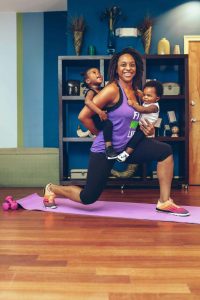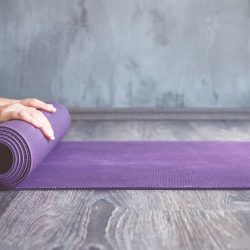
The full interview
Or scroll down to read the highlights.
The highlights
What are some myths around exercise & fitness that all new and expecting moms should be aware of?
I find that many women are misled by outdated fitness guidelines. I hear women say things like, ‘Oh, I don’t know how to stay active’, and they’re referring to guidelines that are more than 5-10 years removed from us. So for example, when I first was pregnant and started exercising, I was told there is a heart rate limit of no more than 140 beats per minute during exercise. This is not true. There is no heart rate limit during pregnancy. The best indicator is exercise intensity. Ask yourself: How hard am I working? On a scale from 1-10, generally you want to stay around a 6-7 in terms of intensity for health benefits. The exception is vigorous exercisers or athletes. For example, I was very active prior to and during my pregnancy, but I always let the way I feel dictate the intensity and length of my workouts.
There’s also a lot of fear tied to the confusion between what exercises can and can’t be done during pregnancy or postpartum. I prefer to change that language. Most exercises are safe with the appropriate modifications. The focus should be on making safe, appropriate modifications for your fitness level that feel good to your body. For example, lying crunches are not recommended during pregnancy or postpartum, but standing crunches are a safe and effective option.
There are some things to avoid though, just to be safe.
Avoid: Jumping later in pregnancy and early postpartum (unless you are doing water aerobics), anything that puts you at risk for falling, traveling to locations that are at a high altitude, contact sports, and hot yoga.
What else is entailed in having a “healthy” pregnancy? What does that really mean?
Exercise is one component, because you want to not only feel good, you want to also prepare yourself for the life you’re carrying. If you exercise now, it helps with your postpartum recovery as well. So there’s physical benefits.
The way you feel when you’re pregnant, that really matters. Exercise helps us manage the way we feel. I think it also makes us feel more comfortable in our changing bodies when we are working out and we see what we are capable of.
Eating well is really important. Eating for two is definitely a myth. It’s usually about 300-500 extra calories during the second and third trimester that we consume. Ask yourself: Are you eating nutrient dense, colorful foods, and plenty of protein? Remember to eat well balanced, colorful meals and to stay hydrated.
I also think we underestimate sleep. It’s so important to get your rest each night. It’s not especially comfortable to physically be in bed when you get into those later weeks of pregnancy, but you do need your rest. Think about where you can cut back on expending energy during the day, and prioritize preserving your energy. Rest in general is important. Self care is so important.
What should we know about postpartum fitness? Once the baby comes, what does that mean to “get back to yourself” and “get back to a healthy version of yourself”?
To be honest, I truly believe that we need to have a mindset shift and eliminate the ‘getting back’ expectation. I’m constantly trying to encourage clients to just take that expression and throw it away.
When I had my daughter, the first time, I felt like I had to prove something because I’m an “expert”. Ultimately I did get back to my starting weight, but I also had a C-section and that healing process took more time and patience than I allowed myself. When I had my son, I was close to bouncing back, but I’ve never lost those last five pounds. If I compared my mind the first time to the second time, my second experience was honestly more rewarding, more fulfilling and less stressful than the first one, because I didn’t have an expectation to “bounce back.”
What does the journey postpartum look like? What’s a real expectation to have?

During the first 2-3 weeks, when you’re going outside for a walk, be present. Don’t worry about what you’re not doing. Focus on the walk, and your breathing.
When you get a couple of months in, and perhaps by now you’re actually lifting weights and doing cardio, just try to be present in everything you do. I think what makes moms frustrated is that all we see is the end result and the final destination. We put pressure on ourselves to “get back” to where we started from instead of actually being present at each phase. There’s no way to fast forward the progress. With clients, when they focus on each incremental part of the process, they’re more fulfilled and they can really celebrate their progress along the way from day 1 to month 3.
Be present in the early days and focus on adjusting to your new routine, your baby’s sleeping patterns, etc. We tend to be so focused on our goals, that we forget to factor in a new life and new demands like breastfeeding. It’s all so new. Give it the tender attention it needs.
Finally, by month six, there’s less restraint on what you should or shouldn’t be doing. Every few months you can now set new goals and revisit where you are and how you feel. Just understand that the timeline does not have to be perfect and your goals are based upon where you are and what works for you at that point in time.
We see images of what’s considered “healthy” for new moms postpartum. How would you define healthy?
Your internal health matters first. Can you get through the day and not have back pain while you’re picking up strollers and toys and everything else? Do you have energy to get through everyday life?
Everyone has a different story and a different starting place. There is no ‘right size’ and there’s no one size fits all. My advice is not to compare yourself, not only to other people, but to where you were in high school, in college, or 10-25 years ago. As you age, your body changes. This is normal and okay. It’s important to define your standards for health from your current baseline. Societal norms are definitely not a good starting point.

Her business, Journey2Motherhood Fitness (J2M), offers personalized online and virtual programs with health coaching support, mindset motivation and fitness programs for long-term client success. J2M’s mission is to empower Moms by educating them about exercise, lifestyle management, and self-care.


